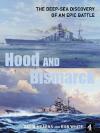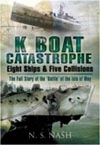Hood and Bismarck
The Deep-Sea Discovery of an Epic Battle
Mearns, David and White, Rob
2001, Channel 4 Books
ISBN 0752220357
Hardcover, 224 pages
| Type. | General History |
| Pros. | Careful, effective combination of description of voyages and losses of the ships, and analysis of the recent searches and explorations of their wrecks. Maps, images, analysis by specialists all solid. |
| Cons. | A little too consciously aware of Ballard’s pioneering work, similar to his earlier work on Bismarck. Text cannot quite capture the power and majesty of the ships, nor the obvious emotion of their rediscovery, though description of loss is well drawn. |
| Rating. |  |
 White and Mearns set themselves quite a challenge in attempting to explore these two vessels, one never before found or sited. They managed, using far more advanced technology than Ballard in 1989, to find them ahead of schedule and on budget, and both commemorate their losses (with sensitivity to the survivors and relatives) and image and photograph the wrecks and debris fields rapidly and effectively. The rediscoveries enabled their specialists Eric Grove and Bill Jurens to revise and enhance the known details about the sinkings and the damage that caused them. All admit the material will support analysis and discussion for years to come.
White and Mearns set themselves quite a challenge in attempting to explore these two vessels, one never before found or sited. They managed, using far more advanced technology than Ballard in 1989, to find them ahead of schedule and on budget, and both commemorate their losses (with sensitivity to the survivors and relatives) and image and photograph the wrecks and debris fields rapidly and effectively. The rediscoveries enabled their specialists Eric Grove and Bill Jurens to revise and enhance the known details about the sinkings and the damage that caused them. All admit the material will support analysis and discussion for years to come.
The book however is a little the prisoner of its material and of type. It is self-consciously commercial, being based on funded research by commercial companies and foundations. It is self-consciously similar to Ballard’s 1989 account of the Bismarck operation and his search for her. Both use the formula of introduction - war - search preparations - Operation Rhine - cut to modern search - cut to Operation Rhine - cut - cut - conclusion, as if there was no other way of holding the audience’s attention. The writing might have benefited, and the recreation and historical account of the events been enhanced, by sticking with the lives of the ships to the end. Only then would you take up the story with how the idea to search for the wrecks was developed from previous salvages by Mearns’ company Blue Water Recoveries, and the research done, the readying, the interviews and ceremonies with survivors’ organisations, and the actual searches.
Readers can carry stories that long, they don’t need the cut back and forth from item to item between advertisements. Separating the ships and the times works against the information and the emotions presented, blunts and divides them. There is no mystery, no need for suspense. The ships are already sunk, and lost, and found, the news out, the details available. Much of the search was webcast live, which is a new and effective presentation tool. But the book is a different kind of medium and will have to stand the test of time.
White is no maritime writer, for all that he tries to be. There is always something missing from the page, a power, a feeling, a sense of being there. He has managed better than many previous staid accounts, but cannot measure up to Kennedy and Briggs, who of course had the inestimable advantage of witnessing some of the events. White’s writing is a little too quick, a little too brief, a little too distant, to really evoke the time and the men. Perhaps the TV version is better, where the faces of the survivors and searchers can be seen, their reactions and emotions felt, the sea and the images of the ships move. This is certainly the case with Ballard’s Bismarck, where the men who were there lend the documentary a thrill and nervousness through their harrowing experiences. Briggs, the sole survivor today of Hood’s last voyage, and some German survivors participated in both documentaries, and their involvement is powerful and important. Their memories and their grief need to be seen and heard. Memories and grief are after all what commemorating and exploring such events are all about.
Nevertheless White’s writing suffices to connect the history and the forensic maritime archaeology, the memories and the technological description of the ships and the sonar sleds and scanners which explore them. The pictures are effective, the commissioned artwork better, though more images less frequently seen would be a bonus. Using the same familiar photos is always a trap, and Mearns and White don’t quite avoid it.
The maps and facsimiles of documents from ship’s logs and from the Hood inquiry are the best features, very powerful in their way. The individual digital images of the ships and wreckage are an order of magnitude better than Ballard’s, which is to be expected. It is only in the packaging and summation that the book lets itself down. While expert analysis proves the causes of the losses of both ships, and gives plenty of supporting information, the description and portrayal of the ships on the seabed is worse. Ballard, overall, provided more and better detail, and combined art, pictures, and images of the wreck better. The art created from photo-montages of Bismarck was far superior to anything here, where the picture-mosaics are less clear and less detailed. There are fewer images, and they show little that Ballard did not, save the lost conning tower of Bismarck. Once again we see shells, plating, boots lying on the seabed where they landed in May 1941, the latter all the more eerie when we can see them side by side, heels outward, the body long gone but the leather boots preserved. In one image a crumpled leather coat lies decaying on the mud, boots beside it, where its owner landed in it, with a soft thump, all those years ago.
Given the state of her wreck, Hood’s description is also quite limited, once the problems of tide and water quality were compensated for. There seems to be a lot of information, both visual and technical, but much is held back. There was simply more about Bismarck, more of a sense of actually being at the wreck, in Ballard’s work. This is somewhat disappointing, given the price and size of this new book, and given the excitement with which it was awaited. Readers have been waiting since 1989 for someone to go after Hood. Now she is found, and in a condition which allows detailed coverage, we get less of what was discovered, than we would like. While Mearns and White’s account is not a failure, nor a disappointment, it could have been written better, with more of a sense of period, and given more information, and better representations of the wreck sites, than either Ballard achieved or they actually present. It is a good account, but not a great one.
The reviewer welcomes your comments on this review.
Review written by Ian Campbell, Launceston, Tasmania.
Published on 17 Jun 2002.
Purchase information: (info) Get Hood and Bismarck now at amazon.com ($ 30.44)
Get Hood and Bismarck now at amazon.com ($ 30.44) Get Hood and Bismarck now at amazon.co.uk
Get Hood and Bismarck now at amazon.co.uk
Return to our main review page.



